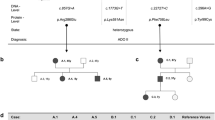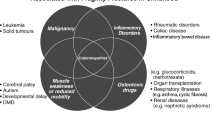Abstract
Significant fracture history in children is defined as having at least one vertebral fracture, at least 2 fractures by age 10, or at least 3 fractures by age 19. Between September 2011 and December 2014, clinical data were collected on children with a significant fracture history that attended a major Australian children’s hospital. Fifty-six patients were identified as having 305 fractures in total, including 44 vertebral fractures. 18% of patients (10/56) were diagnosed with osteogenesis imperfecta (OI) by a bone health expert, molecular testing or both, and they sustained 23% of all fractures (71/305). Analysis of serum bone biochemistry showed all median values to be within a normal range and no clinically significant differences between patients with and without OI. The DXA and pQCT derived bone mineral density (BMD) and bone mineral content (BMC) Z scores were reduced overall. DXA derived total body and lumbar spine areal BMD-for-age and BMC-for-age Z scores were significantly lower in children who had vertebral fractures or who were later diagnosed with OI. Similarly, pQCT performed on radii and tibiae showed Z scores significantly less than zero. pQCT-derived limb muscle cross sectional area Z scores were significantly lower in the OI subgroup. In conclusion, this study describes the bone phenotype of children referred to a tertiary hospital clinic for recurrent fractures and highlights a subset of children with previously undiagnosed OI, but a larger cohort without classic OI. Thus it can be clinically challenging to differentiate between children with OI type 1 (mild phenotype) and non-OI children without bone densitometry and genetic testing. We conclude that recurrent fractures in children should prompt a comprehensive bone and systemic health assessment to eliminate an underlying pathology.



Similar content being viewed by others
References
Landin LA (1983) Fracture patterns in children. Analysis of 8,682 fractures with special reference to incidence, etiology and secular changes in a Swedish urban population 1950–1979. Acta Orthop Scand Suppl 202:1–109
Clark EM (2014) The epidemiology of fractures in otherwise healthy children. Curr Osteoporos Rep 12(3):272–278
Moustaki M, Lariou M, Petridou E (2001) Cross country variation of fractures in the childhood population. Is the origin biological or “accidental”? Injury Prev 7(1):77
Korula S, Titmuss AT, Biggin A, Munns CF (2015) A practical approach to children with recurrent fractures. Endocr Dev 28:210–225
Bishop N, Arundel P, Clark E, Dimitri P, Farr J, Jones G et al (2014) Fracture prediction and the definition of osteoporosis in children and adolescents: the ISCD 2013 pediatric official positions. J Clin Densitom 17(2):275–280
Bianchi ML, Leonard MB, Bechtold S, Hogler W, Mughal MZ, Schonau E et al (2014) Bone health in children and adolescents with chronic diseases that may affect the skeleton: the 2013 ISCD pediatric official positions. J Clin Densitom 17(2):281–294
Glorieux FH, Rowe D (2012) Osteogenesis Imperfecta. In: Glorieux FH, Pettifor JM, Juppner H (eds) In: Pediatric bone: biology and diseases, 2 edn. Academic Press, London, pp 511–539
Sillence DO, Rimoin DL (1978) Classification of osteogenesis imperfect. Lancet 311(8072):1041–1042
Rauch F, Glorieux FH (2004) Osteogenesis imperfecta. Lancet 363(9418):1377–1385
Makitie RE, Kampe AJ, Taylan F, Makitie O (2017) Recent discoveries in monogenic disorders of childhood bone fragility. Curr Osteoporos Rep 15(4):303–310
Kuczmarski RJ, Ogden CL, Guo SS, Grummer-Strawn LM, Flegal KM, Mei Z et al (2000) CDC Growth Charts for the United States: methods and development. Vital and health statistics Series 11, Data from the national health survey. (246):1-190
National Health and Medical Research Council (2013) Summary guide for the management of overweight and obesity in primary care. Melbourne: National Health and Medical Research Council
Genant HK, Jergas M, Palermo L, Nevitt M, Valentin RS, Black D et al (1996) Comparison of semiquantitative visual and quantitative morphometric assessment of prevalent and incident vertebral fractures in osteoporosis The Study of Osteoporotic Fractures Research Group. J Bone Miner Res 11(7):984–996
Lu PW, Briody JN, Ogle GD, Morley K, Humphries IR, Allen J et al (1994) Bone mineral density of total body, spine, and femoral neck in children and young adults: a cross-sectional and longitudinal study. J Bone Miner Res 9(9):1451–1458
Hogler W, Briody J, Woodhead HJ, Chan A, Cowell CT (2003) Importance of lean mass in the interpretation of total body densitometry in children and adolescents. J Pediatr 143(1):81–88
Moyer-Mileur LJ, Quick JL, Murray MA (2008) Peripheral quantitative computed tomography of the tibia: pediatric reference values. J Clin Densitom 11(2):283–294
Rauch F, Schoenau E (2005) Peripheral quantitative computed tomography of the distal radius in young subjects—new reference data and interpretation of results. J Musculoskelet Neuronal Interact 5(2):119–126
Rauch F, Schoenau E (2008) Peripheral quantitative computed tomography of the proximal radius in young subjects—new reference data and interpretation of results. J Musculoskelet Neuronal Interact 8(3):217–226
Munns CF, Shaw N, Kiely M, Specker BL, Thacher TD, Ozono K et al (2016) Global consensus recommendations on prevention and management of nutritional rickets. J Clin Endocrinol Metab 101(2):394–415
Hill ID, Fasano A, Guandalini S, Hoffenberg E, Levy J, Reilly N et al (2016) NASPGHAN clinical report on the diagnosis and treatment of gluten-related disorders. J Pediatr Gastroenterol Nutr 63(1):156–165
Wake M, Maguire B (2012) Chidren’s body mass index: cohort, age and socio-economic influences. Annual statistical report 2012
Jones IE, Williams SM, Goulding A (2004) Associations of birth weight and length, childhood size, and smoking with bone fractures during growth: evidence from a birth cohort study. Am J Epidemiol 159(4):343–350
Goulding A, Grant AM, Williams SM (2005) Bone and body composition of children and adolescents with repeated forearm fractures. J Bone Miner Res 20(12):2090–2096
Goulding A, Taylor RW, Jones IE, McAuley KA, Manning PJ, Williams SM (2000) Overweight and obese children have low bone mass and area for their weight. Int J Obes Relat Metab Disord 24(5):627–632
Farr JN, Funk JL, Chen Z, Lisse JR, Blew RM, Lee VR et al (2011) Skeletal muscle fat content is inversely associated with bone strength in young girls. J Bone Miner Res 26(9):2217–2225
Deere K, Sayers A, Viljakainen HT, Lawlor DA, Sattar N, Kemp JP et al (2013) Distinct relationships of intramuscular and subcutaneous fat with cortical bone: findings from a cross-sectional study of young adult males and females. J Clin Endocrinol Metab 98(6):E1041–E1049
Kelley JC, Crabtree N, Zemel BS (2017) Bone density in the obese child: clinical considerations and diagnostic challenges. Calcif Tissue Int 100(5):514–527
Hedstrom EM, Svensson O, Bergstrom U, Michno P (2010) Epidemiology of fractures in children and adolescents. Acta Orthop 81(1):148–153
Cooper C, Dennison EM, Leufkens HG, Bishop N, van Staa TP (2004) Epidemiology of childhood fractures in Britain: a study using the general practice research database. J Bone Miner Res 19(12):1976–1981
Rennie L, Court-Brown CM, Mok JY, Beattie TF (2007) The epidemiology of fractures in children. Injury 38(8):913–922
Lyons RA, Sellstrom E, Delahunty AM, Loeb M, Varilo S (2000) Incidence and cause of fractures in European districts. Arch Dis Child 82(6):452–455
Mayranpaa MK, Viljakainen HT, Toiviainen-Salo S, Kallio PE, Makitie O (2012) Impaired bone health and asymptomatic vertebral compressions in fracture-prone children: a case-control study. J Bone Miner Res 27(6):1413–1424
Crabtree NJ, Arabi A, Bachrach LK, Fewtrell M, El-Hajj Fuleihan G, Kecskemethy HH et al (2014) Dual-energy X-ray absorptiometry interpretation and reporting in children and adolescents: the revised 2013 ISCD pediatric official positions. J Clin Densitom 17(2):225–242
Clark EM, Ness AR, Bishop NJ, Tobias JH (2006) Association between bone mass and fractures in children: a prospective cohort study. J Bone Miner Res 21(9):1489–1495
Ferrari SL, Chevalley T, Bonjour JP, Rizzoli R (2006) Childhood fractures are associated with decreased bone mass gain during puberty: an early marker of persistent bone fragility? J Bone Miner Res 21(4):501–507
Farr JN, Tomas R, Chen Z, Lisse JR, Lohman TG, Going SB (2011) Lower trabecular volumetric BMD at metaphyseal regions of weight-bearing bones is associated with prior fracture in young girls. J Bone Miner Res 26(2):380–387
Cheng S, Xu L, Nicholson PH, Tylavsky F, Lyytikainen A, Wang Q et al (2009) Low volumetric BMD is linked to upper-limb fracture in pubertal girls and persists into adulthood: a seven-year cohort study. Bone 45(3):480–486
Kalkwarf HJ, Laor T, Bean JA (2011) Fracture risk in children with a forearm injury is associated with volumetric bone density and cortical area (by peripheral QCT) and areal bone density (by DXA). Osteoporos Int 22(2):607–616
Skaggs DL, Loro ML, Pitukcheewanont P, Tolo V, Gilsanz V (2001) Increased body weight and decreased radial cross-sectional dimensions in girls with forearm fractures. J Bone Miner Res 16(7):1337–1342
Marini JC (1988) Osteogenesis imperfecta: comprehensive management. Adv Pediatr 35:391–426
Bardai G, Ward LM, Trejo P, Moffatt P, Glorieux FH, Rauch F (2017) Molecular diagnosis in children with fractures but no extraskeletal signs of osteogenesis imperfecta. Osteoporos Int 28(7):2095–2101
Reinus WR, McAlister WH, Schranck F, Chines A, Whyte MP (1998) Differing lumbar vertebral mineralization rates in ambulatory pediatric patients with osteogenesis imperfecta. Calcif Tissue Int 62(1):17–20
Rauch F, Land C, Cornibert S, Schoenau E, Glorieux FH (2005) High and low density in the same bone: a study on children and adolescents with mild osteogenesis imperfecta. Bone 37(5):634–641
Palomo T, Glorieux FH, Schoenau E, Rauch F (2016) Body composition in children and adolescents with osteogenesis imperfecta. J Pediatr 169:232–237
Olney RC, Mazur JM, Pike LM, Froyen MK, Ramirez-Garnica G, Loveless EA et al (2008) Healthy children with frequent fractures: how much evaluation is needed? Pediatrics 121(5):890–897
Brudvik C, Hove LM (2003) Childhood fractures in Bergen, Norway: identifying high-risk groups and activities. J Pediatr Orthop 23(5):629–634
Mayranpaa MK, Makitie O, Kallio PE (2010) Decreasing incidence and changing pattern of childhood fractures: a population-based study. J Bone Miner Res 25(12):2752–2759
Kyriakou A, Shepherd S, Mason A, Ahmed SF (2016) Prevalence of vertebral fractures in children with suspected osteoporosis. J Pediatr 179:219–225
Acknowledgements
We extend our thanks to the participants and their families for accepting to be part of this study.
Funding
The current work was undertaken with a research grant from Osteoporosis Australia and the Australia New Zealand Bone and Mineral Society.
Author information
Authors and Affiliations
Corresponding author
Ethics declarations
Conflict of interest
Dr Fiscaletti reports grants from Osteoporosis Australia/ANZBMS, during the conduct of the study; personal fees from Alexion, outside the submitted work. Mr Coorey reports grants from Osteoporosis Australia/ANZBMS, during the conduct of the study. Dr Biggin reports grants from Osteoporosis Australia/ANZBMS, during the conduct of the study. Ms Briody reports grants from Osteoporosis Australia/ANZBMS, during the conduct of the study. Professor Little reports grants from Osteoporosis Australia/ANZBMS, during the conduct of the study; grants and non-financial support from Novartis Pharma, grants from N8 Medical, grants from Celgene, grants and non-financial support from Amgen Inc., personal fees from Orthopediatrics, outside the submitted work. Associate Professor Schindeler reports grants from Osteoporosis Australia/ANZBMS, during the conduct of the study; grants and non-financial support from Novartis Pharma, grants from N8 Medical, grants from Celgene, grants and non-financial support from Amgen Inc, outside the submitted work. Professor Munns reports grants from Osteoporosis Australia/ANZBMS, during the conduct of the study; grants from Ultragenyx, grants and personal fees from Alexion, grants from Amgen, grants from Novartis, and grant from GSK, outside the submitted work.
Human and Animal Rights and Informed Consent
This article does not contain any studies with human or animal subjects performed by any of the authors.
Rights and permissions
About this article
Cite this article
Fiscaletti, M., Coorey, C.P., Biggin, A. et al. Diagnosis of Recurrent Fracture in a Pediatric Cohort. Calcif Tissue Int 103, 529–539 (2018). https://doi.org/10.1007/s00223-018-0449-6
Received:
Accepted:
Published:
Issue Date:
DOI: https://doi.org/10.1007/s00223-018-0449-6




